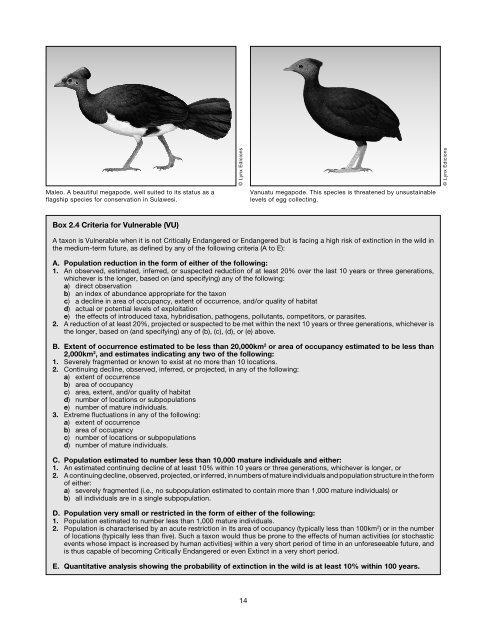Megapodes: Status Survey and Conservation Action Plan ... - IUCN
Megapodes: Status Survey and Conservation Action Plan ... - IUCN
Megapodes: Status Survey and Conservation Action Plan ... - IUCN
You also want an ePaper? Increase the reach of your titles
YUMPU automatically turns print PDFs into web optimized ePapers that Google loves.
Maleo. A beautiful megapode, well suited to its status as a<br />
flagship species for conservation in Sulawesi.<br />
© Lynx Edicions<br />
Vanuatu megapode. This species is threatened by unsustainable<br />
levels of egg collecting.<br />
© Lynx Edicions<br />
Box 2.4 Criteria for Vulnerable (VU)<br />
A taxon is Vulnerable when it is not Critically Endangered or Endangered but is facing a high risk of extinction in the wild in<br />
the medium-term future, as defined by any of the following criteria (A to E):<br />
A. Population reduction in the form of either of the following:<br />
1. An observed, estimated, inferred, or suspected reduction of at least 20% over the last 10 years or three generations,<br />
whichever is the longer, based on (<strong>and</strong> specifying) any of the following:<br />
a) direct observation<br />
b) an index of abundance appropriate for the taxon<br />
c) a decline in area of occupancy, extent of occurrence, <strong>and</strong>/or quality of habitat<br />
d) actual or potential levels of exploitation<br />
e) the effects of introduced taxa, hybridisation, pathogens, pollutants, competitors, or parasites.<br />
2. A reduction of at least 20%, projected or suspected to be met within the next 10 years or three generations, whichever is<br />
the longer, based on (<strong>and</strong> specifying) any of (b), (c), (d), or (e) above.<br />
B. Extent of occurrence estimated to be less than 20,000km 2 or area of occupancy estimated to be less than<br />
2,000km 2 , <strong>and</strong> estimates indicating any two of the following:<br />
1. Severely fragmented or known to exist at no more than 10 locations.<br />
2. Continuing decline, observed, inferred, or projected, in any of the following:<br />
a) extent of occurrence<br />
b) area of occupancy<br />
c) area, extent, <strong>and</strong>/or quality of habitat<br />
d) number of locations or subpopulations<br />
e) number of mature individuals.<br />
3. Extreme fluctuations in any of the following:<br />
a) extent of occurrence<br />
b) area of occupancy<br />
c) number of locations or subpopulations<br />
d) number of mature individuals.<br />
C. Population estimated to number less than 10,000 mature individuals <strong>and</strong> either:<br />
1. An estimated continuing decline of at least 10% within 10 years or three generations, whichever is longer, or<br />
2. A continuing decline, observed, projected, or inferred, in numbers of mature individuals <strong>and</strong> population structure in the form<br />
of either:<br />
a) severely fragmented (i.e., no subpopulation estimated to contain more than 1,000 mature individuals) or<br />
b) all individuals are in a single subpopulation.<br />
D. Population very small or restricted in the form of either of the following:<br />
1. Population estimated to number less than 1,000 mature individuals.<br />
2. Population is characterised by an acute restriction in its area of occupancy (typically less than 100km 2 ) or in the number<br />
of locations (typically less than five). Such a taxon would thus be prone to the effects of human activities (or stochastic<br />
events whose impact is increased by human activities) within a very short period of time in an unforeseeable future, <strong>and</strong><br />
is thus capable of becoming Critically Endangered or even Extinct in a very short period.<br />
E. Quantitative analysis showing the probability of extinction in the wild is at least 10% within 100 years.<br />
14
















